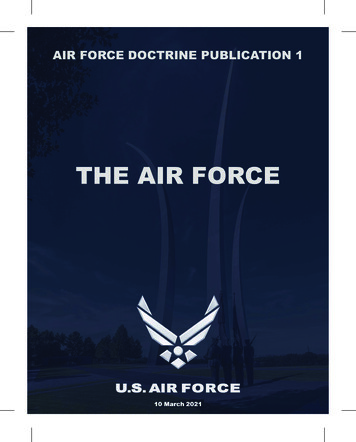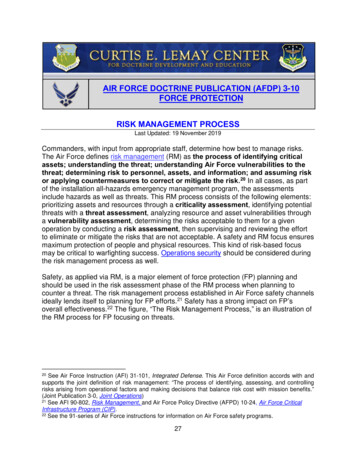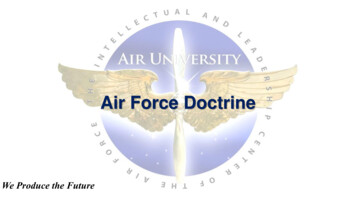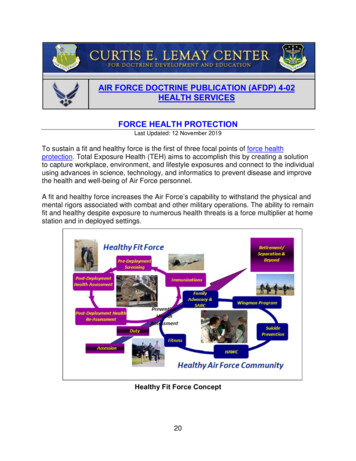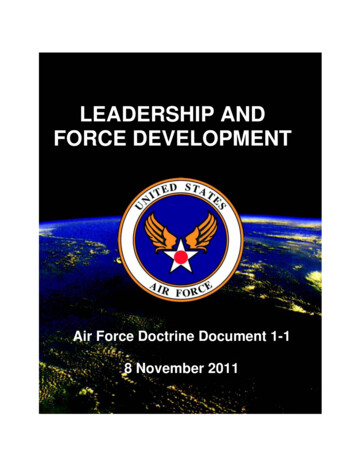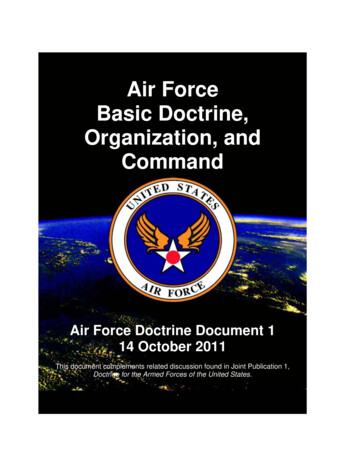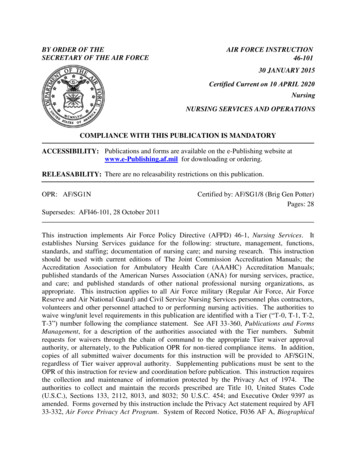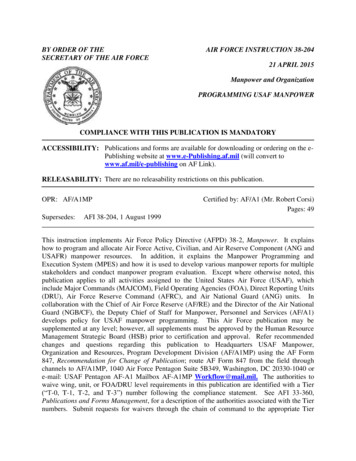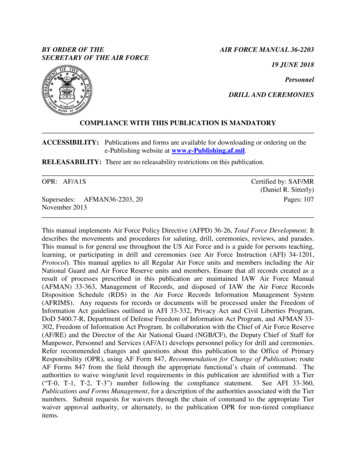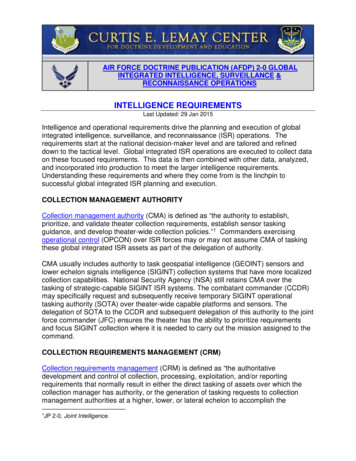
Transcription
AIR FORCE DOCTRINE PUBLICATION (AFDP) 2-0 GLOBALINTEGRATED INTELLIGENCE, SURVEILLANCE &RECONNAISSANCE OPERATIONSINTELLIGENCE REQUIREMENTSLast Updated: 29 Jan 2015Intelligence and operational requirements drive the planning and execution of globalintegrated intelligence, surveillance, and reconnaissance (ISR) operations. Therequirements start at the national decision-maker level and are tailored and refineddown to the tactical level. Global integrated ISR operations are executed to collect dataon these focused requirements. This data is then combined with other data, analyzed,and incorporated into production to meet the larger intelligence requirements.Understanding these requirements and where they come from is the linchpin tosuccessful global integrated ISR planning and execution.COLLECTION MANAGEMENT AUTHORITYCollection management authority (CMA) is defined as “the authority to establish,prioritize, and validate theater collection requirements, establish sensor taskingguidance, and develop theater-wide collection policies.” 1 Commanders exercisingoperational control (OPCON) over ISR forces may or may not assume CMA of taskingthese global integrated ISR assets as part of the delegation of authority.CMA usually includes authority to task geospatial intelligence (GEOINT) sensors andlower echelon signals intelligence (SIGINT) collection systems that have more localizedcollection capabilities. National Security Agency (NSA) still retains CMA over thetasking of strategic-capable SIGINT ISR systems. The combatant commander (CCDR)may specifically request and subsequently receive temporary SIGINT operationaltasking authority (SOTA) over theater-wide capable platforms and sensors. Thedelegation of SOTA to the CCDR and subsequent delegation of this authority to the jointforce commander (JFC) ensures the theater has the ability to prioritize requirementsand focus SIGINT collection where it is needed to carry out the mission assigned to thecommand.COLLECTION REQUIREMENTS MANAGEMENT (CRM)Collection requirements management (CRM) is defined as “the authoritativedevelopment and control of collection, processing, exploitation, and/or reportingrequirements that normally result in either the direct tasking of assets over which thecollection manager has authority, or the generation of tasking requests to collectionmanagement authorities at a higher, lower, or lateral echelon to accomplish the1JP 2-0, Joint Intelligence.
collection mission.” CRM and validation of collection requirement requests for an AORoften resides at the combatant command level but may be delegated to a JFC. CRMfocuses on the requirements of the customer, is all source oriented, and indicates whatinformation is necessary for collection.COLLECTION OPERATIONS MANAGEMENT (COM)Collection operations management (COM) is defined as “authoritative direction,scheduling, and control of specific collection operations and associated processing,exploitation, and reporting resources.” COM is often delegated to an echelon below theJFC (usually the commander, Air Force forces [COMAFFOR]), when that echelon hasthe required expertise in daily collection operations for specific ISR assets. COM is thetasking, scheduling, and control of specific collection, processing and exploitationassets to satisfy joint force requirements that have been validated and prioritized via theCRM process.COMMANDER’S CRITICAL INFORMATION REQUIREMENTSPlanning and direction of global integrated ISR operations start with the identification ofneeds for intelligence regarding all aspects of the operational environment. ThePresident and Secretary of Defense direct JFCs engage in adaptive planning for theconduct of operations. The JFC should then provide the commander’s criticalinformation requirements (CCIRs) to the joint staff and components.CCIRs are information requirements identified by the commander as being critical tofacilitating timely decision-making. The two key elements are friendly force informationrequirements and priority intelligence requirements. 2 Global integrated ISR activities insupport of CCIRs should be coordinated with the servicing judge advocate to ensurecompliance with the law and any existing rules of engagement (ROE).PRIORITY INTELLIGENCE REQUIREMENTSIn the course of intelligence planning and direction, intelligence planners identify theintelligence required to answer the CCIRs. Those intelligence requirements deemedmost important to mission accomplishment are identified as priority intelligencerequirements (PIRs). PIRs are general statements of intelligence need. Examples ofPIRs are as follows: “what is the operational status of the adversary’s integrated airdefense system?” or “what terrorist groups are active within the area ofresponsibility/interest (AOR/AOI)?”PIRs provide the framework for prioritization of all global integrated ISR operationswithin a CCMD. PIRs are driven by, and in turn drive, the joint intelligence preparationof the operational environment (JIPOE) process to refine information requirements andsupport the commander’s potential courses of action. The designation of intelligencerequirements ensures efforts are focused on critical information needed to supportwarfighters. Additionally, PIRs drive the development of detailed EEIs.2JP 3-0, Joint Operations.
ESSENTIAL ELEMENTS OF INFORMATIONEssential elements of information (EEIs) further define the commander’s priorityintelligence requirements by outlining specific information requirements. An example ofan EEI is as follows: “what is the current location of the adversary SA-20 battery?” EEIsare linked to PIRs in order to trace accountability for global integrated ISR operations tocommander priorities. As commander direction and guidance evolve, planners maydevelop new EEI requirements or modify existing requirements.REQUESTS FOR INFORMATIONRequests for information (RFIs) are used to task and manage intelligence analysisrequirements to answer CCIRs and PIRs. If analysis cannot be performed within anorganization, RFIs for intelligence analysis from other organizations across thecommunity in support of answering CCIRs and PIRs are coordinated through theautomated requirements management system known as the Community On-LineIntelligence System for End Users.PCPADWithin a CCMD, the planning and direction; collection; processing and exploitation;analysis and production; and dissemination (PCPAD) process of planning globalintegrated ISR operations begins once the above requirements have been established,validated, and prioritized. As intelligence collection requirements are aligned withavailable collection capabilities; the planning process addresses such factors as theavailability of ISR assets, platform and sensor capabilities, adversary threats to assets,and timeliness of a global integrated ISR response. These factors, when weighedtogether, affect how ISR assets are tasked and employed. In order to make theplanning process more efficient, information requesters should clearly articulate theircollection requirements and allow the CMs and operations planners to decide the bestway to meet the requirements.An optimal global integrated ISR strategy should be designed to maximize battlespaceawareness. ISR strategy is encapsulated within the joint air operation plan and issynchronized with theater and national architectures and strategies. It provides thefoundation for development and validation of intelligence requirements, captures theframework for planning and direction of global integrated ISR operations, andestablishes guidance for the operation of all other elements of the global integrated ISRprocesses.PLANNING AND DIRECTIONPlanning and direction is defined as “the determination of intelligence requirements,development of appropriate intelligence architecture, preparation of a collection plan,and issuance of orders and requests to information collection agencies.” 3 Planning anddirection of global integrated ISR activities involves synchronizing and integrating theactivities of collection, processing and exploitation, analysis and production, anddissemination resources to meet information requirements of national and military3JP 2-01, Joint and National Intelligence Support to Military Operations.
decision-makers at all levels. Precise planning will mitigate and potentially defeat thetraditional adversary advantages of surprise, speed, stealth, maneuver and initiative.For example, campaign planners rely on global integrated ISR to provide theintelligence crucial to understanding an adversary’s weaknesses and key nodes thatcan be affected by air, space, land, maritime, cyberspace and information operations.Intelligence analysis helps detect/discover, identify, locate, and describe the vulnerable,vital elements of an adversary’s physical and virtual structure and their COG. In thisway Air Force global integrated ISR brings significant strengths to foreign internaldefense and counterinsurgency (COIN), not the least of which is identifying key areasalong the borders and monitoring traffic in coordination with host nations (HN).COLLECTIONCollection is defined as “the acquisition of information and the provision of thisinformation to processing elements.” 4 The collection portion of the intelligence processinvolves tasking appropriate assets or resources to acquire the data and informationrequired. Collection includes the identification, prioritization, coordination, andpositioning of assets or resources in all domains to satisfy intelligence requirements. Aunique advantage is that several platforms used for collection provide an opportunity tominimize the US footprint. Global integrated ISR assets can be based outside of theAOI or sequestered on airfields within the AOI that are relatively isolated from thepopulation.PROCESSING AND EXPLOITATIONProcessing and exploitation is defined as “the conversion of collected information intoforms suitable to the production of intelligence.” 5 Once the data satisfying therequirements are collected, they undergo processing and exploitation. Throughprocessing and exploitation, the collected raw data is transformed into information thatcan be readily disseminated, used, exploited, transmitted, stored, and retrieved byintelligence analysts. Relevant critical information should also be disseminated to thecommander and staff to facilitate time-sensitive decision making. Processing andexploitation time varies depending on the characteristics of specific collection assets.For example, some systems accomplish processing automatically and nearlysimultaneous with collection. However, other collection assets, such as humanintelligence (HUMINT) teams, may require additional time. Processing and exploitationrequirements are prioritized and synchronized with the commander’s PIRs.During processing and exploitation, collected data is correlated and converted into aformat suitable for analysis and production. Processing and exploitation remain distinctfrom analysis and production in that the resulting information receives tier one analysisfor time-critical production but has not been subjected to full analytical assessment.Relevant time-sensitive information resulting from this step in the process (especiallytargeting, personnel recovery, or threat warning information) should be immediatelydisseminated through intelligence broadcasts, secure information workspace or internetrelay chat channels, imagery product libraries (IPLs), intelligence databases, ormessage reporting.45JP 2-01, Joint and National Intelligence Support to Military Operations.JP 2-01, Joint and National Intelligence Support to Military Operations.
ANALYSIS AND PRODUCTIONAnalysis and production is defined as “the conversion of processed information intointelligence through the integration, evaluation, analysis, and interpretation of all sourcedata and the preparation of intelligence products in support of known or anticipated userrequirements.” 6 Integrated multi-domain ISR-generated data can provide understandingof demographics, culture, physical terrain, centers of gravity, and financial, social, andpolitical infrastructures. Global integrated ISR must fuse all-source intelligence dataand rapidly disseminate finished, timely, accurate and actionable intelligence toconsumers in order to facilitate command decisions and rapid response options.Analysis and production are accomplished through a structured series of actions which,usually occurring sequentially, may also take place concurrently. These actions includethe integration, evaluation, analysis, and interpretation of information in response toknown or anticipated intelligence production requirements. Integration. Information from single or multiple sources is received, collated, andentered into appropriate databases by the analysis and production elements ofintelligence community organizations, the theater joint intelligence operationscenters (JIOCs) or subordinate joint force elements like the ISR division. Informationis integrated and grouped with related pieces of data according to predeterminedcriteria to facilitate the evaluation of newly received information. Evaluation. Each new item of information is evaluated by the appropriate analysisand production element with respect to the reliability of the source and the credibilityof the information. The reliability of the source and the credibility of the informationshould be assessed independently of each other to avoid bias. Analysis. During analysis, assessments are made by comparing integrated andevaluated information with known facts and predetermined assumptions. Theseassessments are combined and assessed to discern patterns, links or recognizedevents. Analysis can also result in identification of opportunities or knowledge gapsthat drive future collection. Examples of analytical activities include pattern of lifeanalysis, spatial/temporal analysis, network analysis, trend analysis, forensic-basedanalysis. Interpretation. Interpretation is an inductive process in which the information isjudged in relation to existing information and intelligence. This process involves theidentification of new activity and a decision regarding the significance of that activity.These actions enable intelligence fusion. Fusion is “the process of examining allsources of intelligence and information to derive a complete assessment of activity.” 7To promote fusion, analysts should work in collaborative environments which provideaccess to recognized, and often geographically separated, subject matter experts.Through collaboration, intelligence analysts are able to share information, discussopinions, debate hypotheses, and identify or resolve analytic disagreements. Advances67JP 2-01, Joint and National Intelligence Support to Military Operations.JP 2-0, Joint Intelligence.
in network capabilities greatly enhance analysts’ ability to share, compare, and assessinformation. As databases grow in volume and complexity, potentially vital pieces ofinformation may become increasingly difficult for analysts to find and retrieve. In orderto overcome this limitation, virtual knowledge bases have been designed to serve asintegrated repositories of multiple databases as well as reference documents and opensource material.DISSEMINATIONDissemination is defined as “the delivery of intelligence to users in a suitable form andthe application of the intelligence to appropriate missions, tasks, and functions.” 8Dissemination of global integrated ISR provides the end user information required forapplication in a timely manner. Dissemination can take a variety of forms (i.e.,electronic transmission, hardcopy annotated imagery/maps, direct threat warnings, oraland written reports, briefings, or via various servers allowing structured discovery andretrieval). Most importantly, the dissemination process requires continuousmanagement. Without effective management, communications paths can becomesaturated by information being retransmitted by many intermediate collection agencies,resulting in “circular reporting.” Advances in cyberspace capabilities or technology alsoimprove dissemination by reducing information-to-production timeline for deliveringglobal integrated ISR products. Likewise, some collection systems are capable ofdisseminating collected information to requesters on a real- or near real-time basis,vastly increasing their responsiveness. With this consideration in mind, it is sometimesbetter to get the consumer data immediately rather than processed knowledge too late.Additionally, global integrated ISR planning should include local procedures for rapidlycoordinating with Public Affairs for public release of select intelligence. This expandingcollection capability makes secure network connectivity more important because realtime planning and targeting systems depend on tailored intelligence information. Theintegration of intelligence and operations on a continuous basis allows commanders andall operational planners access to the most current information available; therebyoptimizing intelligence support to operation planning, preparation, execution, andassessment functions.8JP 2-01, Joint and National Intelligence Support to Military Operations.
information requirements (CCIRs) to the joint staff and components. CCIRs are information requirements identified by the commander as being critical to facilitating timely decision-making. The two key elements are friendly force information requirements and priority intelligence requirements. 2 Global integrated ISR activities in
